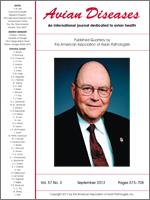We report a case of a falcon breeding facility, where raptors (both diurnal and nocturnal) were raised in contact with domestic fowl (Gallus galllus f. domesticus) infected by Mycobacterium avium subsp. avium. Fecal and environmental samples from 20 raptors and four common ravens (Corvus corax) were collected. Mycobacterium a. avium DNA was detected in feces of four raptors (bald eagle [Haliaeetus leucocephalus], eagle owl [Bubo bubo], barn owl [Tyto alba], and little owl [Athene noctua]) using triplex quantitative real-time PCR. As both the flock of domestic fowl and one of the infected raptors had the same origin (zoological collection), they might have had a common source of colonization/infection. However, the detection of M. a. avium in feces of three other raptors may point at transmission of the agent between the birds in the facility. Contact of raptors with domestic fowl infected by M. a. avium may pose a risk for transmission of the infection for them; however, raptors from the falcon breeding facility seemed to be relatively resistant to the infection.
Reporte de Caso—Mycobacterium avium subsp. avium en aves rapaces expuestas a gallinas infectadas.
Se presenta el caso de un granja de crianza de halcones, donde se criaban aves rapaces (tanto diurnas y nocturnas) en contacto con gallinas (Gallus gallus f. domesticus) infectadas por Mycobacterium avium subsp. avium. Se recogieron muestras fecales y ambientales de 20 aves rapaces y de cuatro cuervos communes (Corvus corax). Se detectó ADN de Mycobacterium a. avium en las heces de cuatro aves rapaces (águila calva [Haliaeetus leucocephalus], búho real [Bubo bubo], lechuza común [Tyto alba] y un mochuelo común [Athene noctua]) utilizando un método de PCR en tiempo real cuantitativo triple. Tanto la parvada de gallinas y una de las aves rapaces tenían un mismo origen (colección zoológica), pudieron haber tenido una fuente de colonización/infección común. Sin embargo, la detección de M. a. avium en las heces de las otras tres aves rapaces pueden indicar la transmisión del agente entre las aves en esta granja. El contacto de las aves rapaces con aves domésticas infectadas por M. a. avium puede suponer un riesgo para la transmisión de la infección para ellos, sin embargo, las aves rapaces de la granja de cría de halcones parecían ser relativamente resistentes a la infección.





